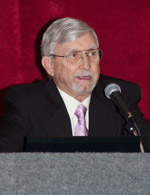General Session I
Size, Efficiency and Complementarity
by Troy Smith for Angus Productions Inc.
HOUSTON, Texas (April 19, 2012) — Asked to speak about how size, efficiency and complementarity affect the way cattle fit their environment, Texas A&M University Professor Emeritus Stephen Hammack claimed he had nothing new to say. “It’s all been talked about before — repeated over the years,” Hammack told an audience gathered for the 2012 Beef Improvement Federation (BIF) Symposium in Houston.

Professor Emeritus
Stephen Hammack
According to Hammack, repeated warnings have been voiced for more than 40 years about the need to place constraints on weaning weight and yearling weight. The industry continued to make cattle bigger. The push continued for increased rate of gain, improved feed-to-gain ratio and other improvements to biological efficiency. But none of the methods used to measure the improvements considered the cost.
Hammack cited numerous statements made by various animal scientists throughout the years warning that a focus on growth traits could be detrimental to the cow herd. They urged the industry to remember that the average cow herd must operate on a fixed resource base. Cows became bigger, they produced more milk and raised bigger calves, but fewer of those bigger cows could be maintained on that fixed resource base.
“There is no inherent advantage in efficiency, from increasing the size of cattle,” Hammack stated.
And many beef breeds became so similar that Hammack sees less opportunity to use different types to achieve complementarity — combine or cross breeds to exploit their strong points and minimize their weaknesses. Also important is how combinations are made. Today, however, Hammack said, maximum complementarity almost requires a terminal breeding system.
In his closing comments, Hammack recommended less emphasis on individual performance and greater attention to herd output, with consideration of the cost.
“It has been estimated that the cow-calf segment requires two-thirds of the total nutrients consumed from conception to product. Economics dictate these nutrients must come primarily from relatively low-cost forages. The U.S. beef industry will not be sustainable if this is ignored,” Hammack stated. “Market preferences are important, but size of cattle will ultimately rest on what is feasible in the nation’s cow herd.”
Return to the Newsroom for links to the PowerPoint presentation that accompanied this presentation.
Editor’s Note: This summary was written under contract or by staff of Angus Productions Inc. (API). Through an agreement with the Beef Improvement Federation, we are encouraging reprinting of the articles to those who will adhere to the reprint guidelines available on this site. Please review those guidelines or contact Shauna Rose Hermel, editor, at 816-383-5270. PowerPoints are posted with permission of the presenter and may not be reproduced in whole or in part without the express permission of the presenter.
API's coverage of the event is made possible through collaboration with BIF and sponsorship of LiveAuctions.tv. For questions about this site, or to notify us of broken links, click here.
Headquartered in Saint Joseph, Mo., API publishes the Angus Journal, the Angus Beef Bulletin, the Angus Beef Bulletin EXTRA, and the Angus e-List, as well as providing online coverage of events and topics pertinent to cattlemen through the API Virtual Library.



